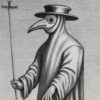FFS: Post Dural Puncture Headache
Post Dural Puncture Headache (PDPH) is a specific type of headache that occurs following dural puncture during:
- Accidental dural puncture during epidural insertion
- Spinal anaesthesia
- Diagnostic lumbar puncture
Pathophysiology
Mechanism
- Loss of CSF leads to reduced brain buoyancy, causing traction on pain-sensitive intracranial structures.
- Adenosine-mediated venodilatation may also contribute.
Risk Factors
- Younger age
- Obstetric patients
- Use of large-bore needles (e.g. epidural needle)
Clinical Features
History
- Onset typically within 24–72 hours of dural puncture
- 65% present <24 hours
- 90% present <3 days
- Headache characteristics:
- Postural: relieved lying down, worsens when upright
- Location: frontal or occipital (may also be temporal or nuchal)
- Associated symptoms:
- Nausea, vomiting
- Tinnitus or hearing loss
- Photophobia
Examination
- Usually normal
- Abnormal findings (e.g. fever, neck stiffness) should prompt investigation for meningitis, spinal epidural abscess, or other causes
- Rarely: cranial nerve palsies (e.g. CN VI palsy)
Investigations
- Clinical diagnosis
- Consider investigations only to exclude alternative diagnoses
May include:
- FBC and coagulation profile (if coagulopathy suspected)
- CT or MRI: may show dural venous engorgement; often normal
Management
Most cases resolve spontaneously within 7–10 days.
Conservative Measures
- Rehydration
- IV fluids if dehydrated
- Supine rest
- Simple analgesics
- Paracetamol
- NSAIDs
- Oxycodone (if necessary)
- Antiemetics as needed
- Caffeine
- 500 mg orally or IV once or twice daily
- Cerebral vasoconstriction may help alleviate symptoms
- Second-line pharmacological options
- Hydrocortisone: 200 mg IV bolus, then 100 mg IV TDS for 2 days
- Gabapentin: 300 mg orally TDS for 4 days
Definitive Management
7. Epidural Blood Patch
- Relieves headache via compression of thecal sac and potential sealing of dural defect
- Success rate: 70–90%
Contraindications
- Fever
- Local infection
- Coagulopathy
- Uncooperative patient
Complications
- Infection (meningitis, epidural abscess)
- Repeat dural puncture
- Back pain
Technique
- Performed by anaesthetics staff under sterile conditions in theatre
- 15–30 mL of autologous blood injected into epidural space near puncture site
- May require repeat patch if headache recurs
Post-Procedural Care
- Monitor pain and temperature 4-hourly for 24 hrs
- Bed rest 4 hours, then gradual mobilisation
- Back pain common; usually resolves within 48 hrs
Disposition
- Refer all potential candidates to Anaesthetics
- Admission to SSU may be appropriate (typically ≤2 days)
- Anaesthetics to manage in conjunction with SSU consultant
References
Publications
- Brazis PW, Masdeu JC, Biller J. Localization in Clinical Neurology. 8e 2021
- Fuller G. Neurological Examination Made Easy. 6e 2019
FOAMed
- Miers J. Procedure: Lumbar Puncture. LITFL
- Johnson A. August Karl Gustav Bier. LITFL
- Johnson A. J. Leonard Corning. LITFL
- Coni R. Headache classification. LITFL
- Coni R. Headache Essentials. LITFL
Fellowship Notes
MBBS DDU (Emergency) CCPU. Adult/Paediatric Emergency Medicine Advanced Trainee in Melbourne, Australia. Special interests in diagnostic and procedural ultrasound, medical education, and ECG interpretation. Co-creator of the LITFL ECG Library. Twitter: @rob_buttner
Educator, magister, munus exemplar, dicata in agro subitis medicina et discrimine cura | FFS |


